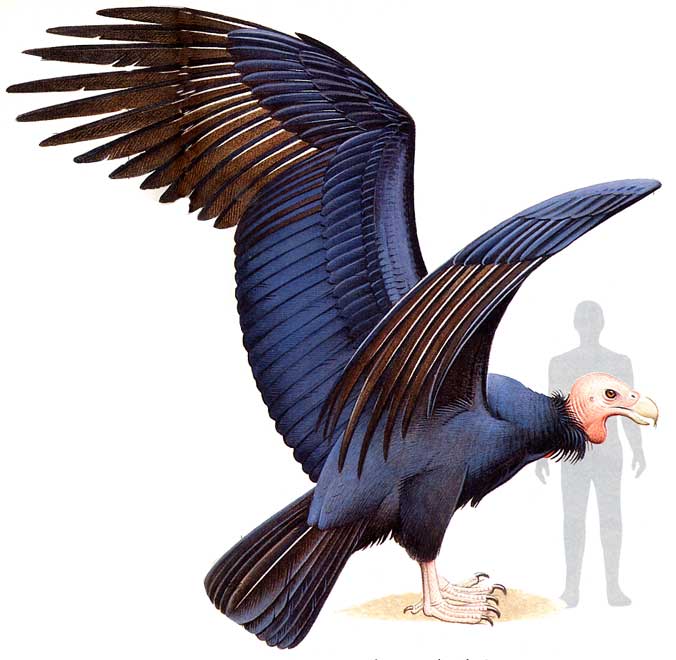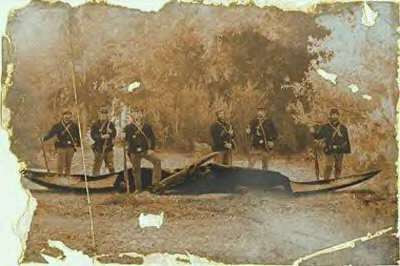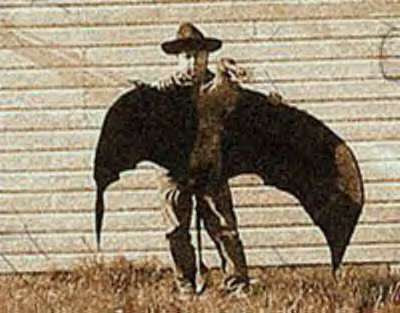Post by MoMo on Jun 18, 2011 14:00:36 GMT -6
Thunderbird

Grouping: Cryptid
Sub grouping: Unknown
First reported: Unknown
Country: Worldwide
Region: Worldwide
Habitat: Air
Thunderbird is a term used in cryptozoology to describe large, bird-like creatures, generally identified with the Thunderbird of Native American tradition. Similar cryptids reported in the Old World are often called Rocs. Thunderbirds are regarded by a small number of researchers as having lizard features like the extinct pterosaurs such as Pteranodon. Although reports of Thunderbird sightings go back centuries, due to the lack of scientific evidence (such as a fossil record), the creature is generally regarded as a myth.
This article deals with modern sightings (the last 200 years) of such a creature, reported as real, as opposed to mythological accounts, though believers in the phenomenon often use the Native American legends in attempts to support their claims.


Early reports
There is a story that in April 1890, two cowboys in Arizona killed a giant birdlike creature with an enormous wingspan. It was said to have had smooth skin, featherless wings like a bat and a face that resembled an alligator. This description has some similarity to that of a prehistoric pterodactyl, an animal whose existence was known at the time. They are supposed to have dragged the carcass back to town, where it was pinned with wings outstretched across the entire length of a barn. A picture of this event may have been published in the local newspaper, the Tombstone Epitaph. Cryptozoology.com has an account of this story with the events taking place in the state of Texas.
According to Mark Hall, the Epitaph did indeed print a story about the capture of a large, unusual winged creature, on April 26, 1890. Beyond this single story, however, no one has made historic corroboration that this event ever occurred; it is usually considered an urban legend. Utterly fictional tall tales were not an uncommon feature in newspapers during this era.
No one has ever produced a copy of the "Thunderbird" photograph, though numerous people, Ivan T. Sanderson being one of the better known, have made claims to its existence. Sanderson claimed to have once owned a copy of the photo, which vanished after he loaned it to an acquaintance in the 1960s. The television program Freaky Links staged a similar photo, giving new life to the "Thunderbird Photograph" legend.
Jerome Clark speculates that the description of the basic image in question (men standing alongside a winged creature nailed to a barn), is evocative enough to implant a sort of false memory, leading some people to vaguely "remember" seeing the photo at some distant, imprecise time.
20th century
There was a spike in Thunderbird sightings in the late twentieth century. On occasion, such reports were accompanied by large footprints or other purported evidence.
Among the most controversial reports is a July 25, 1977 account from Lawndale, Illinois. About 9 P.M. a group of three boys were at play in a residential back yard. Two large birds approached, and chased the boys. Two escaped unharmed, but the third boy, ten-year-old Marlon Lowe, did not. One of the birds reportedly clamped his shoulder with its claws, then lifted Lowe about two feet off the ground, carrying him some distance. Lowe fought against the bird, which released him.
Viewed by some as a tall tale, the descriptions given by the witnesses of these birds match that of an Andean condor: a large black bird, with a white ringed neck and a wingspan up to 10 feet (3 m). However, an Andean condor's talons are not strong enough to lift heavy objects.[citation needed] Loren Coleman and his brother Jerry interviewed several witnesses after the reported event.
21st century
In 2002, a sighting of a large birdlike creature, with a wingspan of around 14 feet (4.3 m), was reported in Alaska. Scientists suggested the giant bird may have simply been a Steller's sea eagle, which have a wingspan of 6–8 feet (1.8–2.4 m).
As recently as 2007, sightings have been claimed in the area around San Antonio, Texas.
Analysis


As mentioned above, some cryptozoologists have theorized the ancient Thunderbird myth to be based on sightings of a real animal with a mistaken assessment of its apparent size. Some skeptics have claimed such a large bird could never have flown, but several flying creatures with huge wingspans are indeed known. The prehistoric vulture-like Argentavis magnificens had a wingspan of around 7 m (23 ft) and was capable of flight. The massive Cretaceous-era pterosaur Quetzalcoatlus northropi (or perhaps Hatzegopteryx thambema) was the largest known flying creature in history, with a wingspan of around 12 m (40 ft). However, the Thunderbird's identity as a pterosaur is unlikely because the Thunderbird is invariably shown having feathers. A pterosaur's wings were made of a membrane of skin stretched over a bony finger, similar to a bat's wings. San Antonio based cryptozoologist Ken Gerhard believes it is a teratorn.
Cryptozoologists also posit that the Thunderbird was associated with storms because they followed the drafts to stay in flight, not unlike the way a modern eagle rides mountain up currents. Cryptozoologist John Keel claims to have mapped several Thunderbird sightings and found that they corresponded chronologically and geographically with storms moving across the United States.
Angelo P. Capparella, an ornithologist at Illinois State University, argues that the existence of such undiscovered large birds is highly unlikely, especially in North America. There is not enough food, Capparella says, in many areas where abnormally large birds are reported. Perhaps more important, according to Capparella, is the lack of sightings by "the legions of competent birdwatchers ... scanning the skies of the U.S. and Canada" who sometimes make "surprising observations" with cameras at the ready. Were there breeding populations of large, unknown birds, Capparella contends they could not remain unknown very long.
There is one genus of extinct flightless-birds from the Americas that has been named Brontornis, whose name literally means "thunder-bird"; however few, if any, cryptozoologists regard this bird as the origin of the Thunderbird because of its flightlessness.




Grouping: Cryptid
Sub grouping: Unknown
First reported: Unknown
Country: Worldwide
Region: Worldwide
Habitat: Air
Thunderbird is a term used in cryptozoology to describe large, bird-like creatures, generally identified with the Thunderbird of Native American tradition. Similar cryptids reported in the Old World are often called Rocs. Thunderbirds are regarded by a small number of researchers as having lizard features like the extinct pterosaurs such as Pteranodon. Although reports of Thunderbird sightings go back centuries, due to the lack of scientific evidence (such as a fossil record), the creature is generally regarded as a myth.
This article deals with modern sightings (the last 200 years) of such a creature, reported as real, as opposed to mythological accounts, though believers in the phenomenon often use the Native American legends in attempts to support their claims.

Early reports
There is a story that in April 1890, two cowboys in Arizona killed a giant birdlike creature with an enormous wingspan. It was said to have had smooth skin, featherless wings like a bat and a face that resembled an alligator. This description has some similarity to that of a prehistoric pterodactyl, an animal whose existence was known at the time. They are supposed to have dragged the carcass back to town, where it was pinned with wings outstretched across the entire length of a barn. A picture of this event may have been published in the local newspaper, the Tombstone Epitaph. Cryptozoology.com has an account of this story with the events taking place in the state of Texas.
According to Mark Hall, the Epitaph did indeed print a story about the capture of a large, unusual winged creature, on April 26, 1890. Beyond this single story, however, no one has made historic corroboration that this event ever occurred; it is usually considered an urban legend. Utterly fictional tall tales were not an uncommon feature in newspapers during this era.
No one has ever produced a copy of the "Thunderbird" photograph, though numerous people, Ivan T. Sanderson being one of the better known, have made claims to its existence. Sanderson claimed to have once owned a copy of the photo, which vanished after he loaned it to an acquaintance in the 1960s. The television program Freaky Links staged a similar photo, giving new life to the "Thunderbird Photograph" legend.
Jerome Clark speculates that the description of the basic image in question (men standing alongside a winged creature nailed to a barn), is evocative enough to implant a sort of false memory, leading some people to vaguely "remember" seeing the photo at some distant, imprecise time.
20th century
There was a spike in Thunderbird sightings in the late twentieth century. On occasion, such reports were accompanied by large footprints or other purported evidence.
Among the most controversial reports is a July 25, 1977 account from Lawndale, Illinois. About 9 P.M. a group of three boys were at play in a residential back yard. Two large birds approached, and chased the boys. Two escaped unharmed, but the third boy, ten-year-old Marlon Lowe, did not. One of the birds reportedly clamped his shoulder with its claws, then lifted Lowe about two feet off the ground, carrying him some distance. Lowe fought against the bird, which released him.
Viewed by some as a tall tale, the descriptions given by the witnesses of these birds match that of an Andean condor: a large black bird, with a white ringed neck and a wingspan up to 10 feet (3 m). However, an Andean condor's talons are not strong enough to lift heavy objects.[citation needed] Loren Coleman and his brother Jerry interviewed several witnesses after the reported event.
21st century
In 2002, a sighting of a large birdlike creature, with a wingspan of around 14 feet (4.3 m), was reported in Alaska. Scientists suggested the giant bird may have simply been a Steller's sea eagle, which have a wingspan of 6–8 feet (1.8–2.4 m).
As recently as 2007, sightings have been claimed in the area around San Antonio, Texas.
Analysis


As mentioned above, some cryptozoologists have theorized the ancient Thunderbird myth to be based on sightings of a real animal with a mistaken assessment of its apparent size. Some skeptics have claimed such a large bird could never have flown, but several flying creatures with huge wingspans are indeed known. The prehistoric vulture-like Argentavis magnificens had a wingspan of around 7 m (23 ft) and was capable of flight. The massive Cretaceous-era pterosaur Quetzalcoatlus northropi (or perhaps Hatzegopteryx thambema) was the largest known flying creature in history, with a wingspan of around 12 m (40 ft). However, the Thunderbird's identity as a pterosaur is unlikely because the Thunderbird is invariably shown having feathers. A pterosaur's wings were made of a membrane of skin stretched over a bony finger, similar to a bat's wings. San Antonio based cryptozoologist Ken Gerhard believes it is a teratorn.
Cryptozoologists also posit that the Thunderbird was associated with storms because they followed the drafts to stay in flight, not unlike the way a modern eagle rides mountain up currents. Cryptozoologist John Keel claims to have mapped several Thunderbird sightings and found that they corresponded chronologically and geographically with storms moving across the United States.
Angelo P. Capparella, an ornithologist at Illinois State University, argues that the existence of such undiscovered large birds is highly unlikely, especially in North America. There is not enough food, Capparella says, in many areas where abnormally large birds are reported. Perhaps more important, according to Capparella, is the lack of sightings by "the legions of competent birdwatchers ... scanning the skies of the U.S. and Canada" who sometimes make "surprising observations" with cameras at the ready. Were there breeding populations of large, unknown birds, Capparella contends they could not remain unknown very long.
There is one genus of extinct flightless-birds from the Americas that has been named Brontornis, whose name literally means "thunder-bird"; however few, if any, cryptozoologists regard this bird as the origin of the Thunderbird because of its flightlessness.







